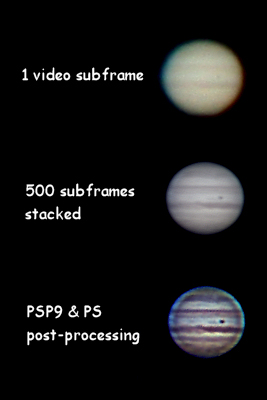Registax & post-processing
Computer assisted planetary and lunar imagery has reached the backyard amateur astronomer. With just a computer, a bunch of free software from Internet and a telescope (or even binoculars) and a point & shoot digital camera you will own the basic setup to do interesting astrophography jobs, mainly in the solar system realm.
The information obtained from a sensor device is pretty blurry, lacking of contrast and noisy as hell when shooting through a telescope or some other instrument with magnification. Atmosphere also conspire against us, because actually it is not as invisible as we thought at first. Windy nights or thermal issues may spoil our footage. That’s way disappointing. But there is a big pro when computer assisted image restoration shows up.
Here it is an example. Jupiter as recorded with a 6-inch telescope. Second step is the result of applying Registax 5 to the sequence. And step 3 is the final touch of sharp, color and contrast enhancement in Photoshop or any other similar software.

2009/09/21 at 9:12 pm
Hi there,
I just took around 20 pictures with a point and shoot Canon A590 IS powershot digital camera and they all came out looking exactly or nearly like the first picture of Jupiter pictured here https://computerphysicslab.wordpress.com/2009/08/09/registax-post-processing/
Do you have any advice on what settings my camera should be on, and I also want to take close ups of the moon’s craters as well.
Thx.
2009/09/22 at 12:23 pm
ISO as low as possible, and shutter speed as fast as possible, but always getting enough light to fill the histogram. If your camera records videos, you can use a software called Registax to get better final images.
2009/09/23 at 3:32 pm
Also, concering this quote:
“By experimenting, I found that my best exposures were 1/160 second, with focus set at infinity and the camera’s built-in optical zoom set to maximum (3x). ”
What does set to infinity mean? Doesnt it mean setting your optical zoom at it’s maximum?
Also, the reason I may be getting blurry images is because:
“As with film astrophotography, you need to obtain perfect focus, since any errors will show up prominently. You can begin by focusing the telescope visually using the eyepiece (if you use prescription glasses, wear them) and setting the camera lens to infinity. If the camera doesn’t have a manual override, just use its autofocus mode.”
Duh, I didnt think of that, I should be setting the foucs through the eyepiece with my glasses on. I think…
2009/09/23 at 4:27 pm
My digicam has an option called “Manual focus” and another one called “Infinity focus”. You may use manual mode and set it to infinity, or you may directly apply the option “Infinity focus” getting the same result.
On the other hand, I set maximum optical zoom, but this is a setting apart from the previous one.
The important thing is to check focus before shooting. If you have saome kind of “live view mode” in your digicam, use it to do the final check in focus.
2009/09/23 at 7:45 pm
It might because I’m stupid, but do you see how I can make it zoom to infinity with this? http://www.steves-digicams.com/camera-reviews/canon/powershot-a590-is/canon-powershot-a590-is-review-2.html
2009/09/23 at 9:36 pm
It seems that according to the webpage you sent, in record mode you press “Down” button to choose the focus mode. I guess there will be several options showed in the screen after pressing the “Down” button, and maybe one of them could be manual focus or infinity focus.
2009/09/24 at 12:38 am
Hi there, I somewhat have a better idea of what your taking about now, but not 100% sure.
This is the camera I have: Canon Powershot A590 IS http://www.steves-digicams.com/camera-reviews/canon/powershot-a590-is/canon-powershot-a590-is-review-2.html
Yes, it does have manual focus setting, when I get there I can adjust the aperture and exposure? 1/25, 1/35, etc..
Can you please help me figure out where I should set some of these settings, hope I’m not asking for too much here…It’s just that I keep reading and dont understand a thing lol. Should I just leave everything on default?
2009/09/24 at 2:43 pm
I don’t know how does your camera settings work … you should talk with someone who owns the same camera model. Try to look for an Internet forum dedicated to your camera model.